AQA A-level BIOLOGY Paper 1 EXAM June 2020
Document Content and Description Below
A-level BIOLOGY Paper 1 Thursday 4 June 2020 Morning Time allowed: 2 hours Materials For this paper you must have: • a ruler with millimetre measurements • a scientific calculator. Ins... tructions • Use black ink or black ball-point pen. • Fill in the boxes at the top of this page. • Answer all questions. • You must answer the questions in the spaces provided. Do not write outside the box around each page or on blank pages. • If you need extra space for your answer(s), use the lined pages at the end of this book. Write the question number against your answer(s). • Show all your working. • Do all rough work in this book. Cross through any work you do not want to be marked. Information • The marks for the questions are shown in brackets. • The maximum mark for this paper is 91. Answer all questions in the spaces provided. box 0 1 Figure 1 shows a cell from the lining of the ileum specialised for absorption of products of digestion. SGLT1 is a carrier protein found in the cell-surface membrane of this cell, it transports glucose and sodium ions (Na+) into the cell. Figure 1 . The action of the carrier protein X in Figure 1 is linked to a membrane-bound ATP hydrolase enzyme. Explain the function of this ATP hydrolase. [2 marks] . The movement of Na+ out of the cell allows the absorption of glucose into the cell lining the ileum. Explain how. [2 marks] 0 1 . 3 Describe and explain two features you would expect to find in a cell specialised for absorption. [2 marks] 1 2 Question 1 continues on the next page Turn over ► box . Figure 2 shows the SGLT1 polypeptide with NH2 at one end and COOH at the other end. Describe how amino acids join to form a polypeptide so there is always NH2 at one end and COOH at the other end. box You may use a diagram in your answer. [2 marks] Space for diagram: Turn over for the next question Turn over ► To study lipid digestion, a scientist placed a tube into the gut of a healthy 20-year-old man. The end of the tube passed through the stomach but did not reach as far as the ileum. The scientist fed the man a meal containing triglycerides through the tube. The scientist also used the tube to remove samples from the man’s gut at intervals after the meal. The scientist measured the type of lipid found in the samples. Some of her results are shown in Table 1. Table 1 Sample Time of collection after meal / min Concentration of fatty acids / mg cm−3 Concentration of triglycerides / mg cm−3 A 45 2.7 0.6 B 75 3.3 0.0 . Use your knowledge of lipid digestion to explain the differences in the results for samples A and B shown in Table 1. box You should assume that no absorption had occurred. [3 marks] . After collecting the samples, the scientist immediately heated them to 70 °C for 10 minutes. Explain why. [2 marks] box . Describe the role of micelles in the absorption of fats into the cells lining the ileum. [3 marks] *07* Turn over ► box . At P on Figure 3, the pressure in the left ventricle is increasing. At this time, the rate of blood flow has not yet started to increase in the aorta. Use evidence from Figure 3 to explain why. [2 marks] *0* . At Q on Figure 3 there is a small increase in pressure and in rate of blood flow in the aorta. Explain how this happens and its importance. box [2 marks] 0 3 . 3 A student correctly plotted the right ventricle pressure on the same grid as the left ventricle pressure in Figure 3. Describe one way in which the student’s curve would be similar to and one way it would be different from the curve shown in Figure 3. [2 marks] Similarity Difference . Use information from Figure 3 to calculate the heart rate of this dog. [1 mark] Turn over ► Anthocyanins are coloured pigments found in the cell vacuole of some plant cells. Anthocyanins cannot move across undamaged cell membranes. A student investigated how to extract anthocyanins from blueberries. She mixed 10 g of crushed, fresh blueberries with 100 cm3 of extraction solvent for 1 hour. She investigated three different extraction solvents: • E – Ethanol, water and acid • F – Ethanol and water • G – Water box . When making up extraction solvent E, the student used a volume ratio of 70:30:1 ethanol:water:acid. Tick () one box that shows the most appropriate volumes she would use to make up 100 cm3 of extraction solvent E. [1 mark] 63.6 cm3 ethanol, 27.3 cm3 water, 9.1 cm3 acid 69.3 cm3 ethanol, 29.7 cm3 water, 1.0 cm3 acid 70.0 cm3 ethanol, 30.0 cm3 water, 1.0 cm3 acid 70.7 cm3 ethanol, 30.3 cm3 water, 1.0 cm3 acid 0 4 . 2 The student kept constant: • the mass of fresh blueberries • the volume of extraction solvent • the time for the mixture to stand. Name two other variables the student should have kept constant during this investigation. [2 marks] 1 2 . After 1 hour, the student filtered the samples. She placed the filtrate in a colorimeter and measured the light absorbance. Her results are shown in Figure 4. Figure 4 Use your knowledge of membrane structure to explain the results in Figure 4. [4 marks] box Turn over ► . A different student did this investigation. He did not have a colorimeter. Describe a method this student could use to prepare colour standards and use them to give data for the total anthocyanin extracted. box [3 marks] Turn over for the next question DO NOT WRITE ON THIS PAGE ANSWER IN THE SPACES PROVIDED box Turn over ► . Describe the role of DNA polymerase in the semi-conservative replication of DNA. [2 marks] box Figure 5 shows the percentage of rat cells undergoing DNA replication. Some cells contained a protein called cyclin D and some cells did not contain cyclin D. All cells were in early interphase at time 0 Figure 5 . It took less time for 25% of cells with cyclin D to be undergoing DNA replication than for 25% of cells without cyclin D. Use Figure 5 to calculate this time difference as a percentage decrease. box Show your working. [2 marks] Answer % . Cyclin D stimulates the phosphorylation of DNA polymerase, which activates the DNA polymerase. Describe how an enzyme can be phosphorylated. [2 marks] . Some tumour cells contain higher than normal concentrations of cyclin D. Use Figure 5 to suggest why higher than normal concentrations of cyclin D could result in a tumour. [2 marks] Turn over ► . Particulate matter is solid particles and liquid particles suspended in air. Polluted air contains more particulate matter than clean air. A high concentration of particulate matter results in the death of some alveolar epithelium cells. If alveolar epithelium cells die inside the human body they are replaced by non-specialised, thickened tissue. Explain why death of alveolar epithelium cells reduces gas exchange in human lungs. [3 marks] box Scientists grew alveolar epithelium cells and exposed the epithelium cells to different concentrations of particulate matter. They calculated the percentage of these alveolar epithelium cells that died after 24 hours of exposure to particulate matter. Their results are shown in Figure 6. Figure 6 . Do the data in Figure 6 show a linear relationship between concentration of particulate matter and percentage of dead cells? Use suitable calculations to justify your answer. [2 marks] Space for your calculations: *17* Turn over ► 0 7 . 1 Alpha-gal is a disaccharide found in red meat. Alpha-gal is made of two galactose molecules. Galactose has the chemical formula C6H12O6 Give the chemical formula for the disaccharide, alpha-gal, and describe how it is formed from two galactose molecules. [2 marks] Formula Description . Some people eat red meat for many years without having any reaction, then have an allergic reaction to the alpha-gal in red meat. An allergic reaction is caused by an immune response. Draw a labelled diagram of an antibody and identify the specific alpha-gal binding site. [3 marks] *1* . A tick is a small animal that bites humans and feeds on their blood. This results in proteins from the tick saliva entering the human body. Scientists have suggested one hypothesis for the allergic reaction to alpha-gal in red meat. They think that an earlier immune response to a tick bite can cause a person to have an allergic reaction to alpha-gal in red meat. box Suggest how one antibody can be specific to tick protein and to alpha-gal. [2 marks] Question 7 continues on the next page Turn over ► 0 7 . 4 Scientists took blood samples from one man over several weeks and measured the concentration of antibody in the man’s blood. During this time, the man had two tick bites and had an allergic reaction to alpha-gal in red meat. The scientists’ results are shown in Figure 7. Figure 7 The scientists’ hypothesis was that an earlier immune response to tick protein causes the allergic reaction. Consider whether Figure 7 supports this hypothesis. [3 marks] 0 8 . 1 Complete Table 2 to show three differences between DNA in the nucleus of a plant cell and DNA in a prokaryotic cell. [3 marks] Table 2 DNA in the nucleus of a plant cell DNA in a prokaryotic cell 1 2 3 . Scientists investigated the genetic diversity between several species of sweet potato. They studied non-coding multiple repeats of base sequences. Define ‘non-coding base sequences’ and describe where the non-coding multiple repeats are positioned in the genome. [2 marks] Question 8 continues on the next page Turn over ► The percentage similarities in the non-coding multiple repeats of base sequences of four species of sweet potato are shown in Table 3. Table 3 Species of sweet potato Percentage similarity between non-coding multiple repeat base sequences C L R T C 53.5 25.7 59.7 L 53.5 33.4 53.7 R 25.7 33.4 36.6 T 59.7 53.7 36.6 . Use the information in Table 3 to complete the phylogenetic tree shown in Figure 8. box Write the letter that represents the correct species into each box. Figure 8 [1 mark] . The scientists studied five individuals from each species. Within the five individuals of species T they found a percentage similarity of 66%. box Use Table 3 to evaluate how this information affects the validity of the phylogenetic tree. [2 marks] Turn over for the next question Turn over ► There are no questions printed on this page DO NOT WRITE ON THIS PAGE ANSWER IN THE SPACES PROVIDED box 0 9 Scientists investigated stomatal density on leaves of one species of tree. Figure 9 shows three examples of the square fields of view the scientists used to calculate a mean stomatal density. Figure 9 . Calculate the mean stomatal density in the three fields of view in Figure 9. Give your answer as number of stomata per mm2 Show your working. [2 marks] Stomatal density per mm2 Question 9 continues on the next page Turn over ► The scientists used leaves from individual trees that had grown in different areas of the world in different years. Each tree had grown in an area and year with known carbon dioxide concentration. Their results are shown in Figure 10. Figure 10 0 9 . 2 Give a null hypothesis for this investigation and name a statistical test that would be appropriate to test your null hypothesis. [2 marks] Null hypothesis Statistical test . From 1910 to 2000, the carbon dioxide concentration in the atmosphere increased from 300 parts per million to 365 parts per million. Use Figure 10 to calculate the mean rate of change in stomatal density from 1910 to 2000. Give your answer as number of stomata per mm2 per 10-year period. box Show your working. [2 marks] Number of stomata per mm2 per 10-year period . A journalist saw Figure 10 and suggested that future increases in atmospheric carbon dioxide concentration could result in less transpiration. Evaluate his suggestion. [4 marks] *27* Turn over ► . Describe how mRNA is formed by transcription in eukaryotes. [5 marks] box *2* . Describe how a polypeptide is formed by translation of mRNA. [6 marks] box Question 10 continues on the next page Turn over ► . Define ‘gene mutation’ and explain how a gene mutation can have: • no effect on an individual • a positive effect on an individual. [4 marks] box END OF QUESTIONS There are no questions printed on this page DO NOT WRITE ON THIS PAGE ANSWER IN THE SPACES PROVIDED box box box box box There are no questions printed on this page DO NOT WRITE ON THIS PAGE ANSWER IN THE SPACES PROVIDED box Copyright information For confidentiality purposes, all acknowledgements of third-party copyright material are published in a separate booklet. This booklet is published after each live examination series and is available for free download from www.aqa.org.uk. Permission to reproduce all copyright material has been applied for. In some cases, efforts to contact copyright-holders may have been unsuccessful and AQA will be happy to rectify any omissions of acknowledgements. If you have any queries please contact the Copyright Team. Copyright © 2020 AQA and its licensors. All rights reserved. [Show More]
Last updated: 1 year ago
Preview 1 out of 36 pages
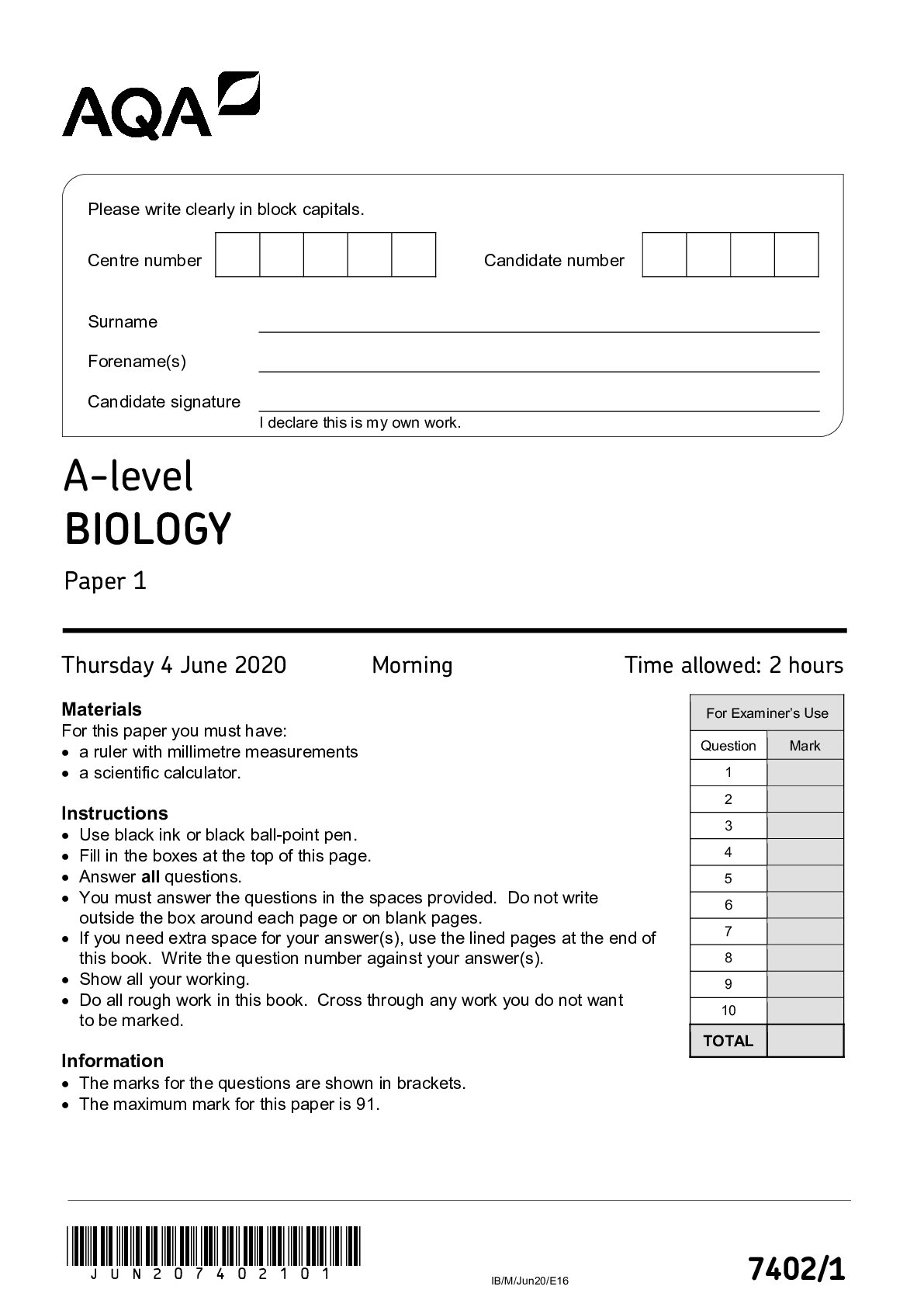
Reviews( 0 )
Document information
Connected school, study & course
About the document
Uploaded On
Aug 31, 2021
Number of pages
36
Written in
Additional information
This document has been written for:
Uploaded
Aug 31, 2021
Downloads
0
Views
263

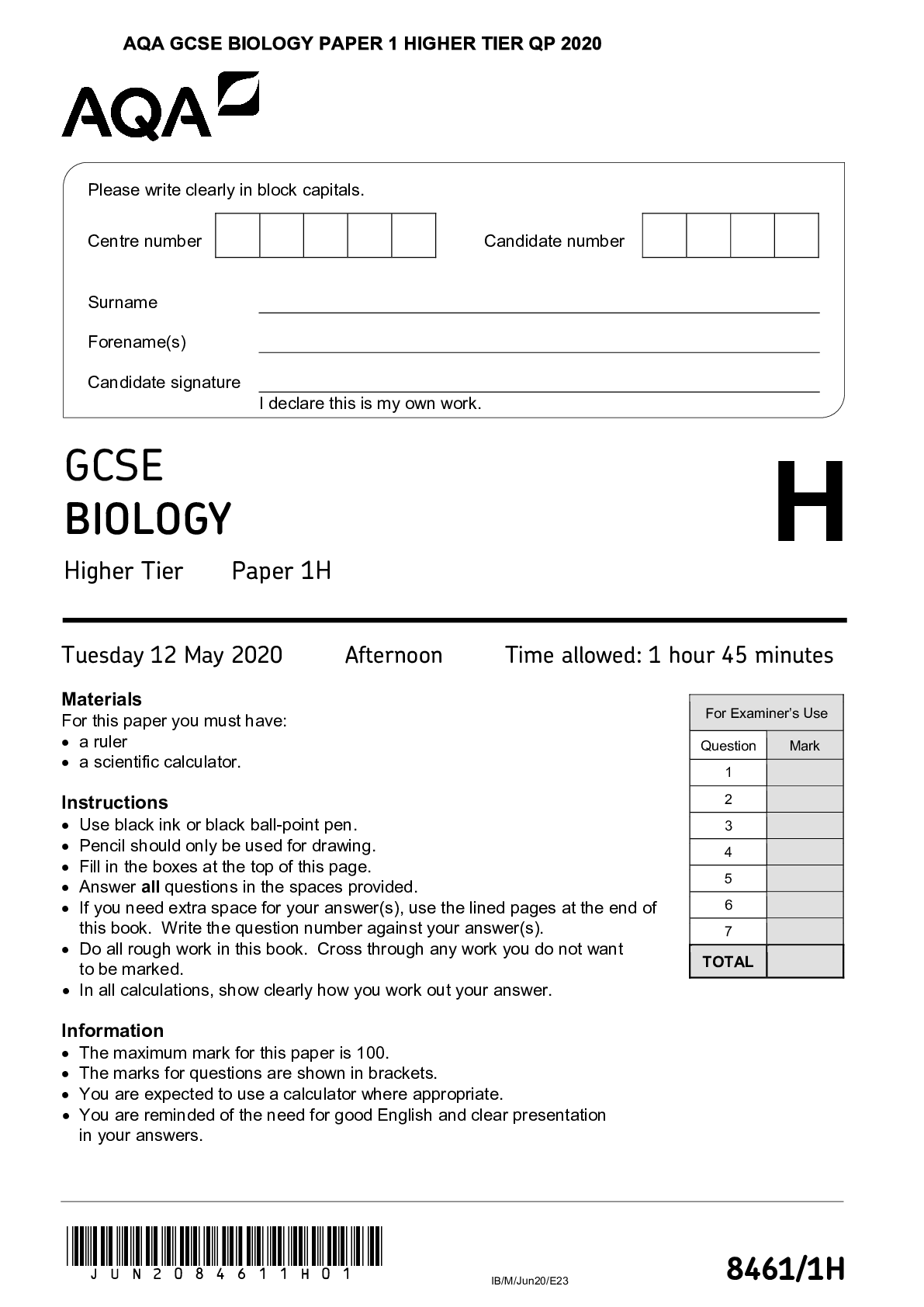
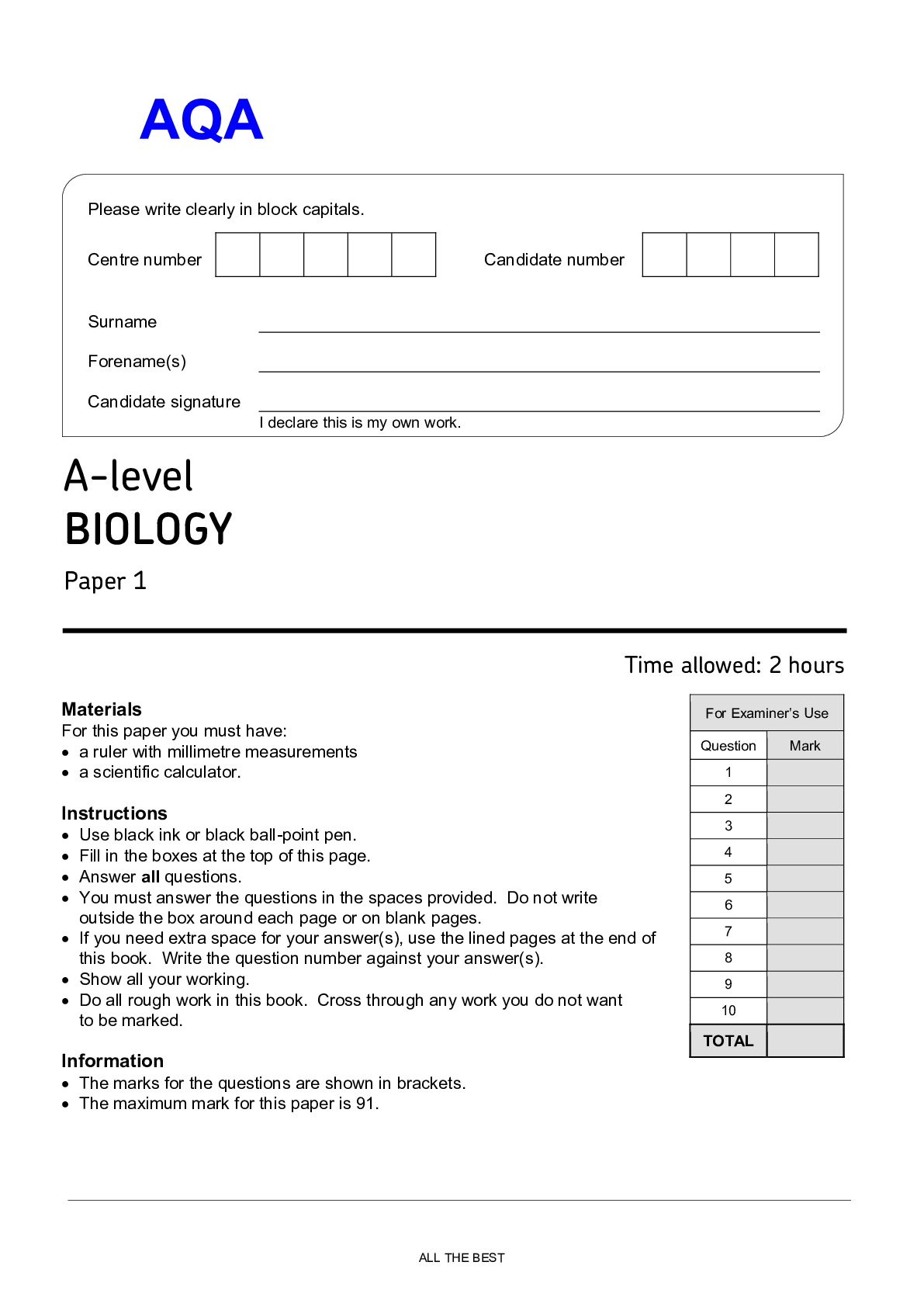

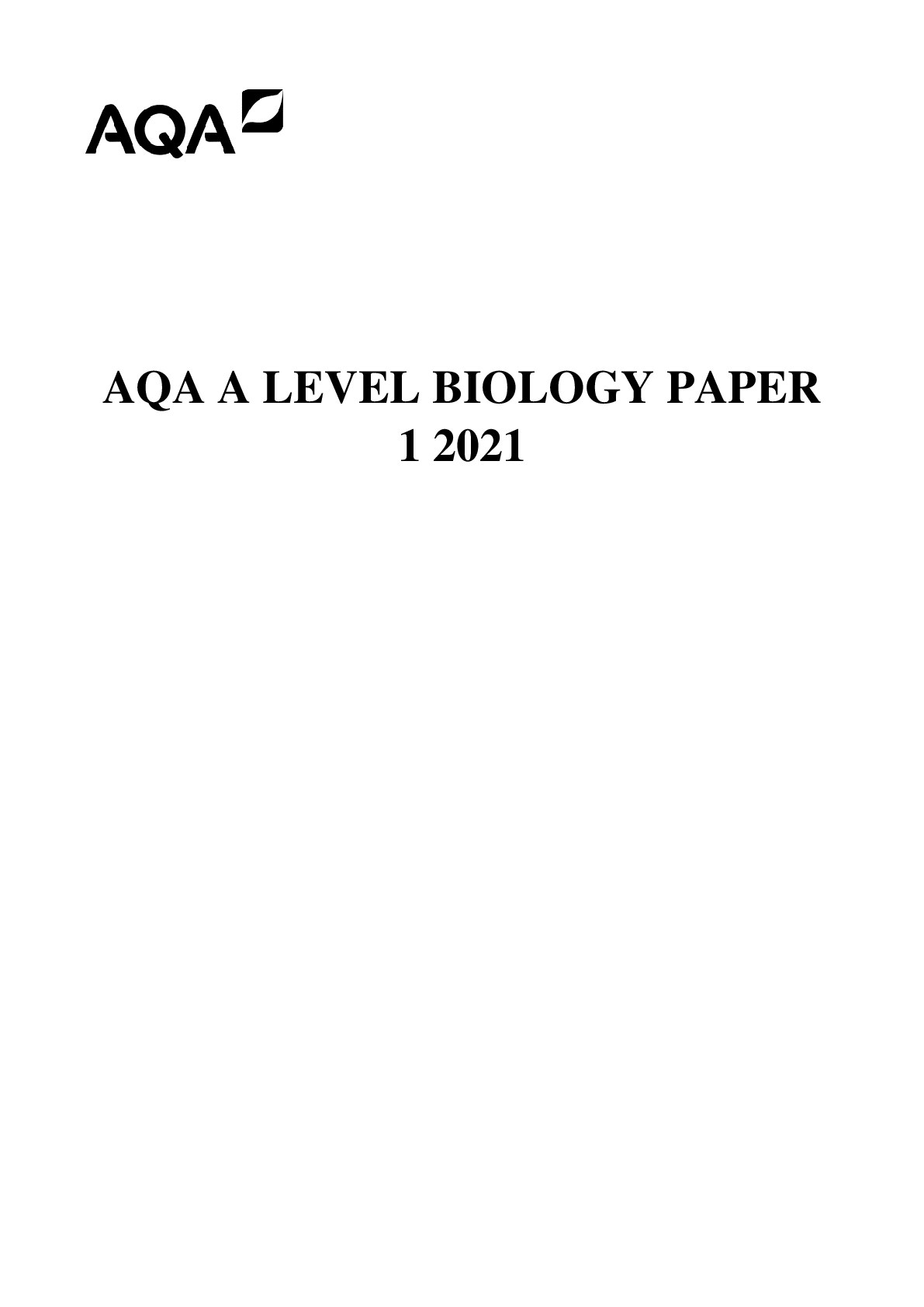
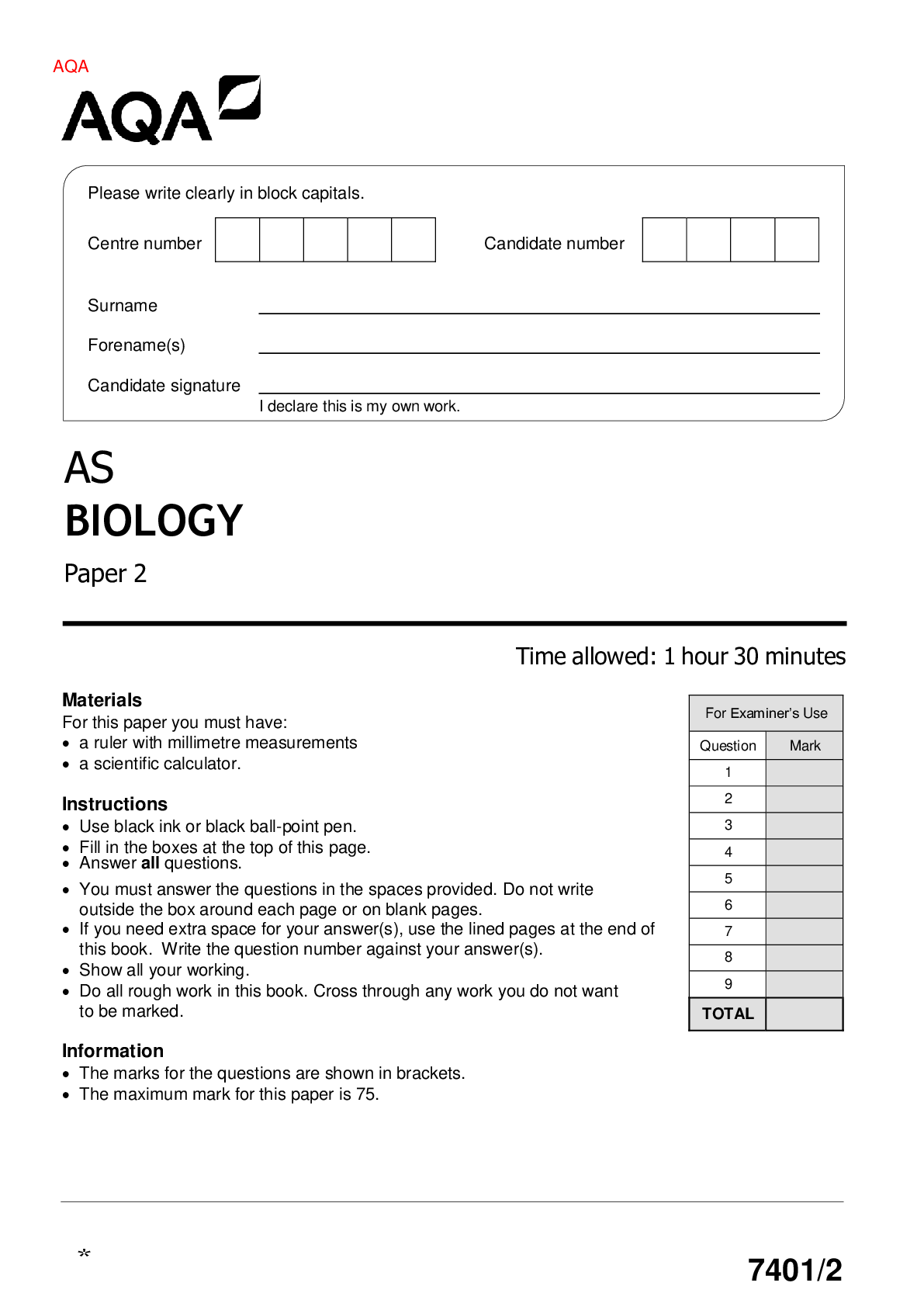
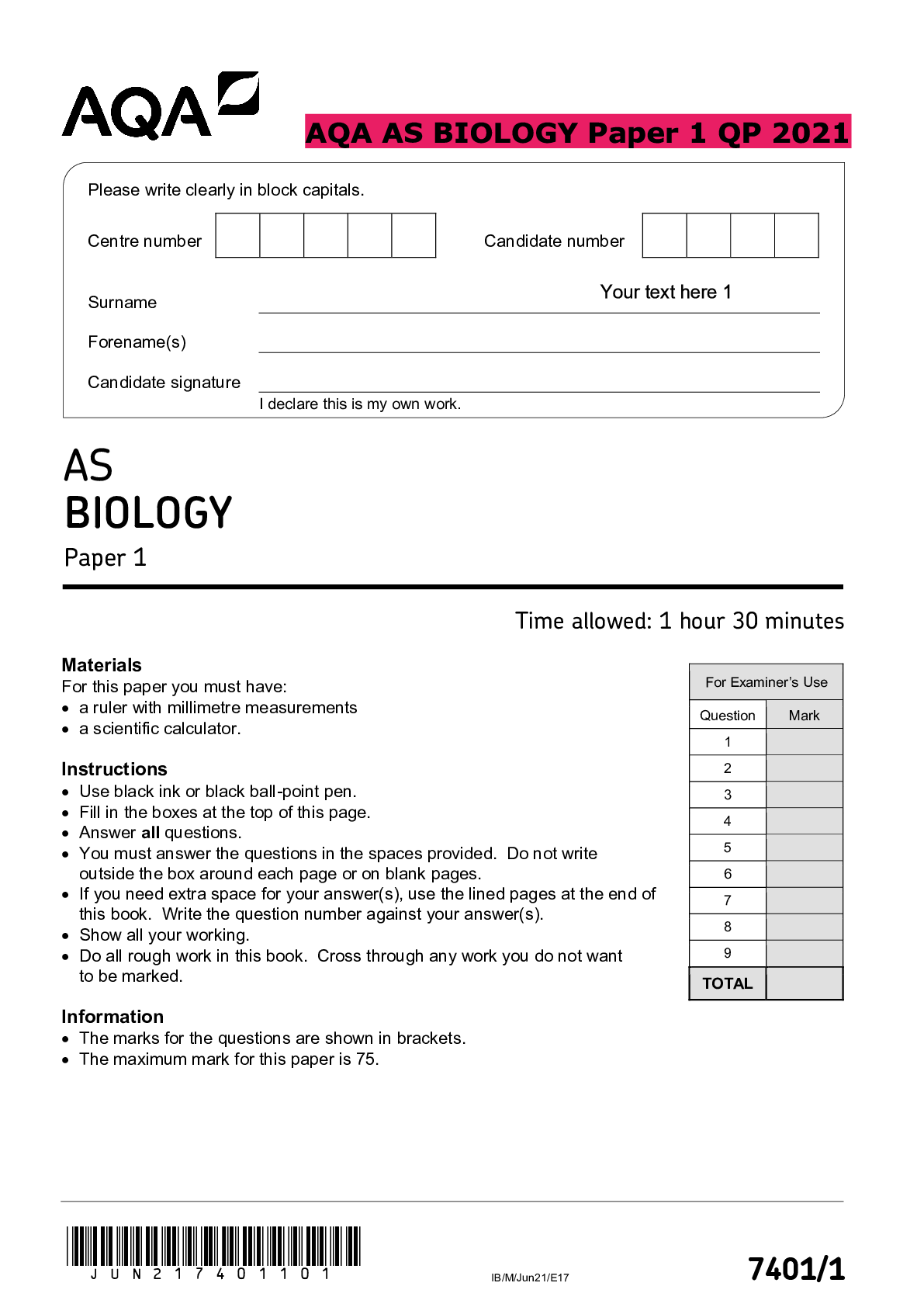
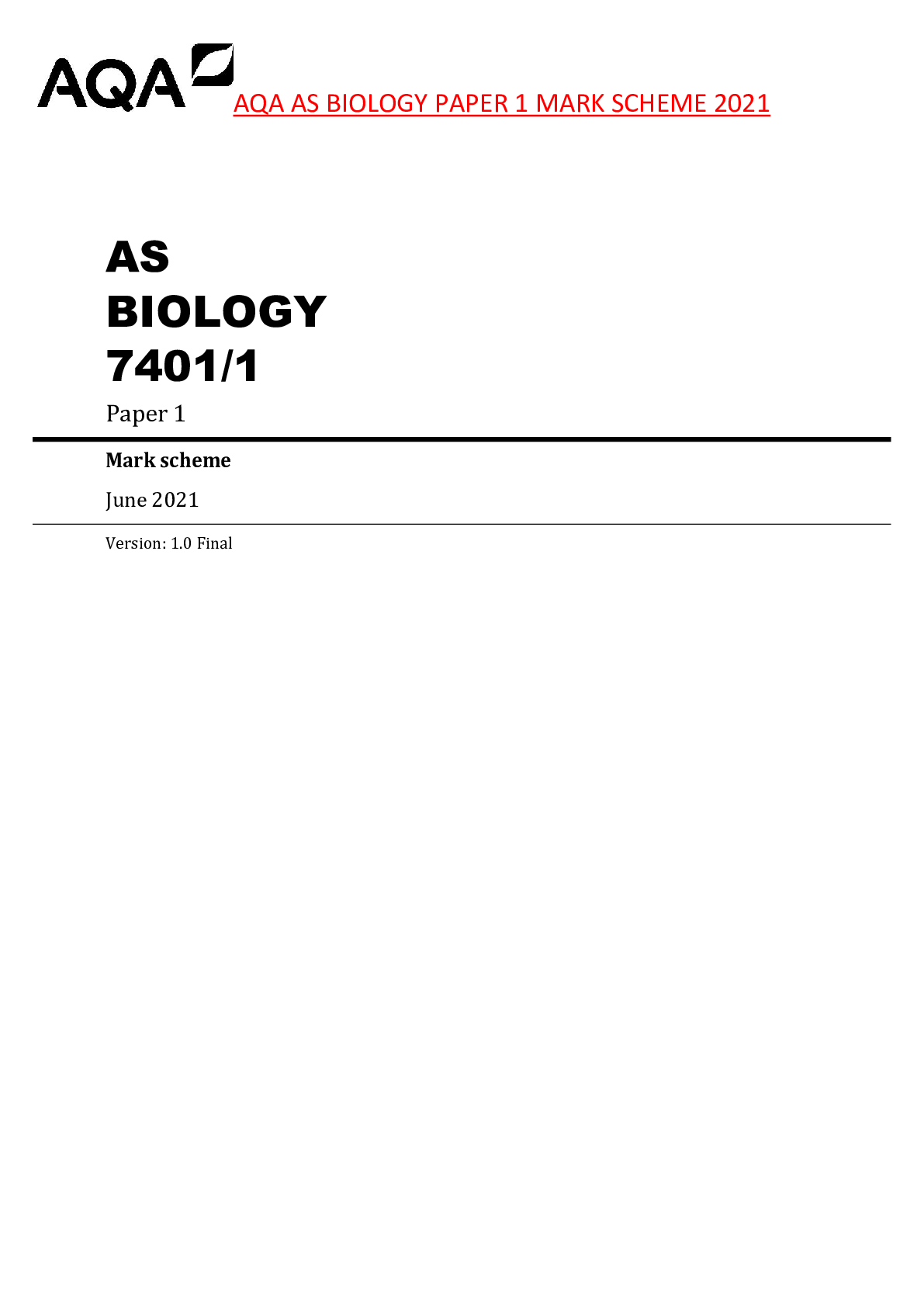
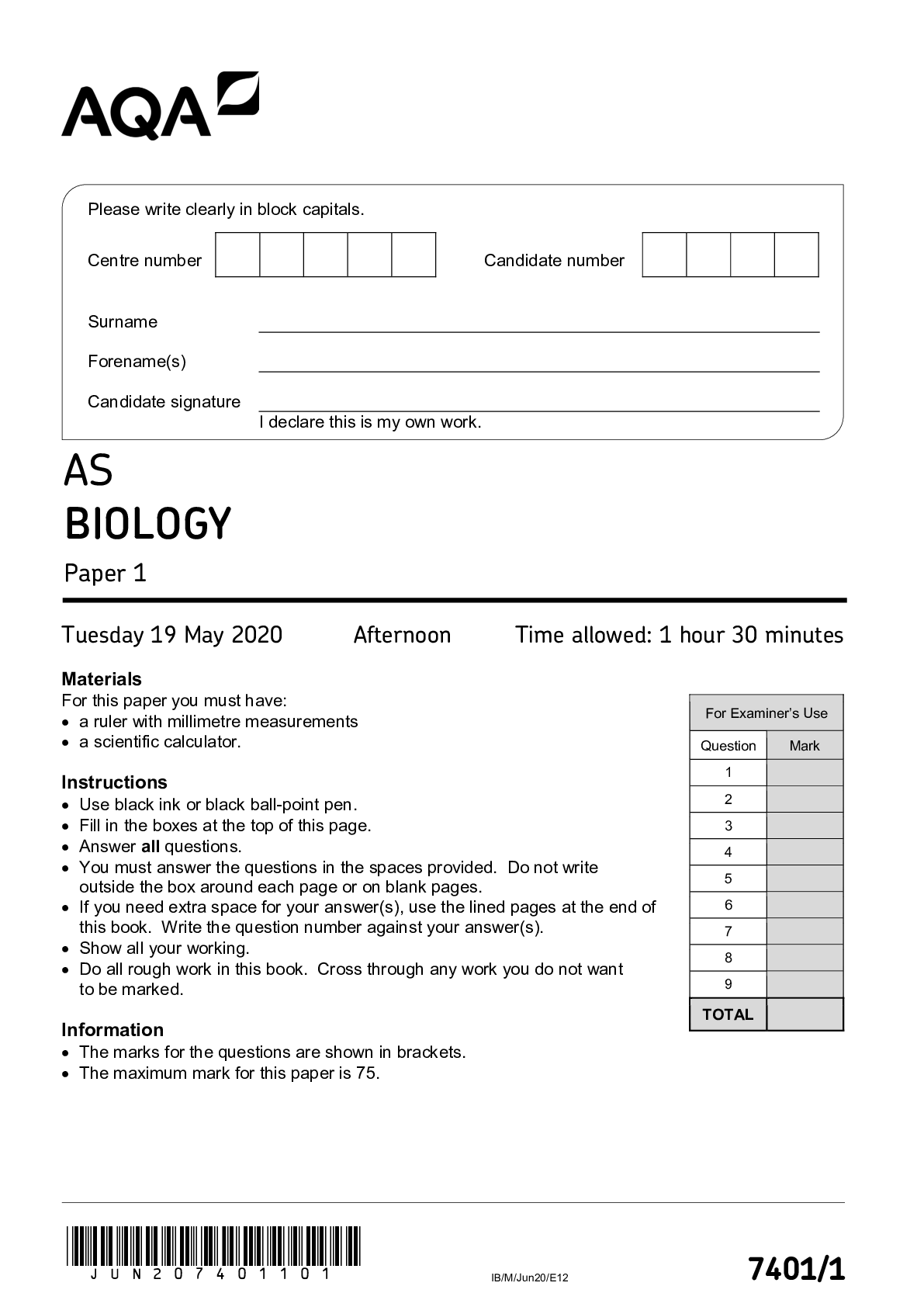
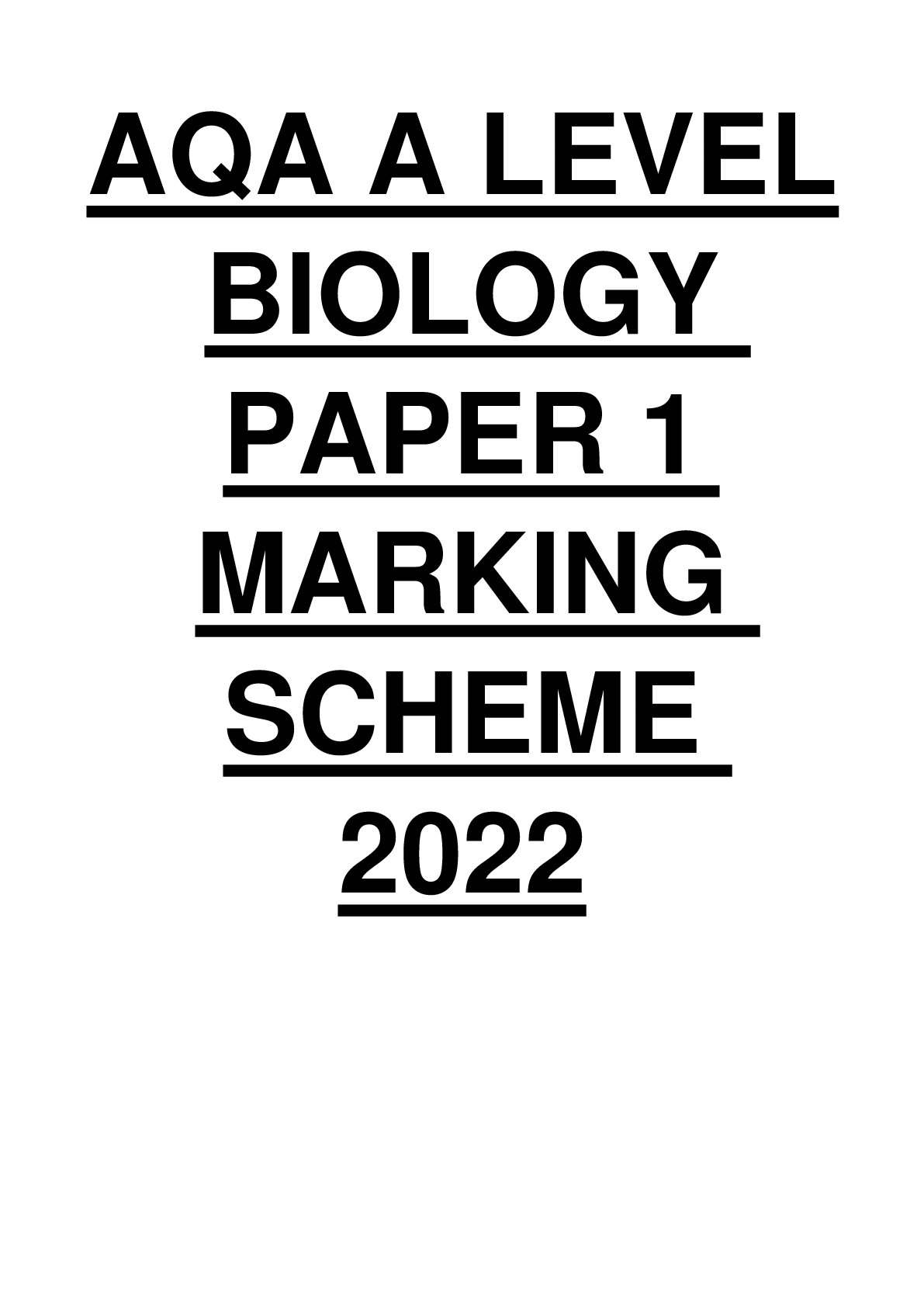
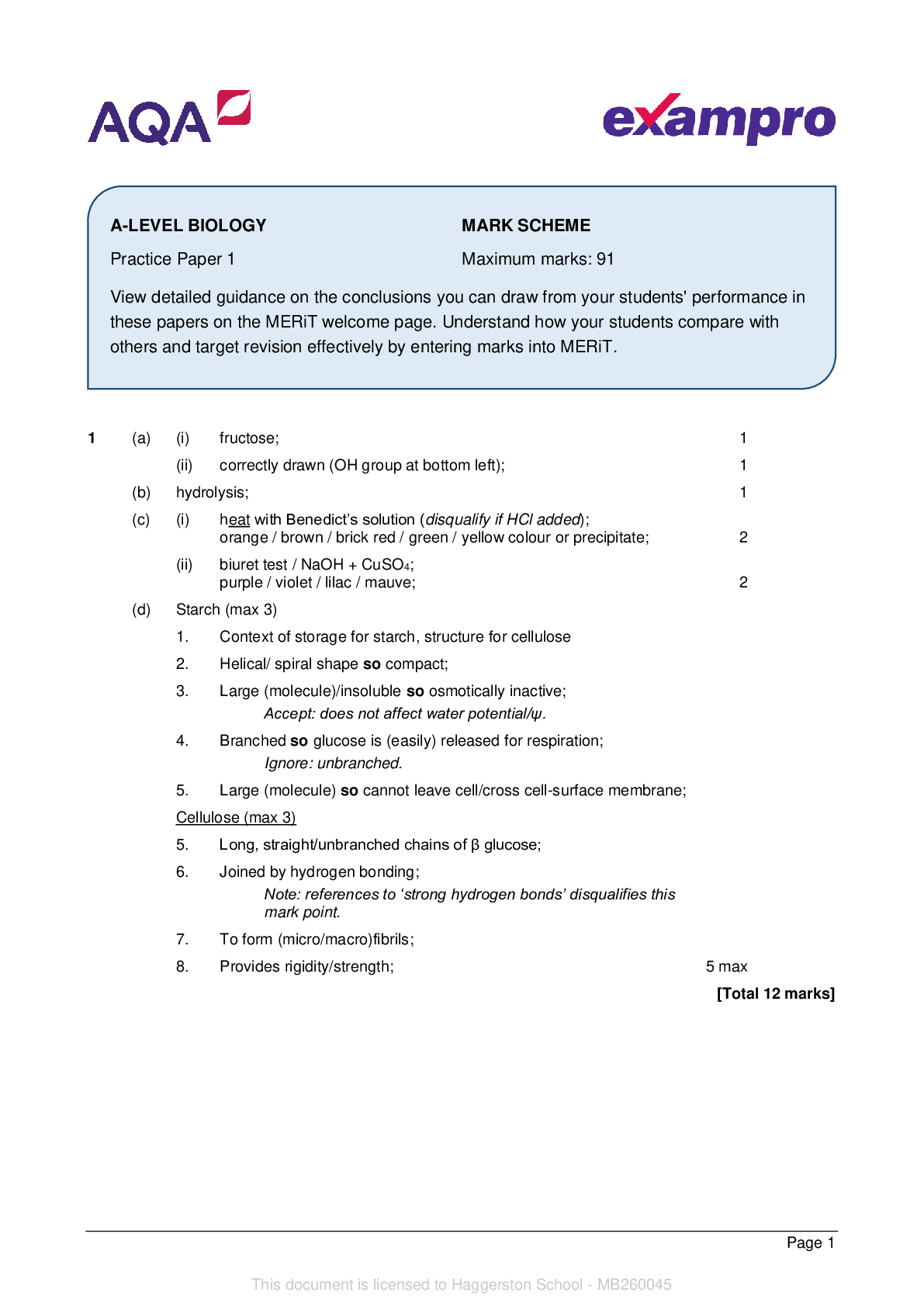

.png)

